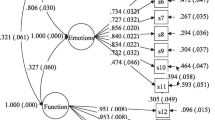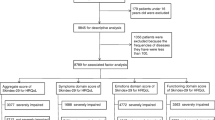Abstract
Purpose
To translate and cross-culturally adapt the Skindex-16, a brief skin-disease-specific QoL questionnaire, into Arabic for Egyptians and to evaluate its measurement properties in Egyptian patients with skin disease.
Method
Translation and cultural adaption were performed following guidelines for cross-cultural adaption of health-related quality of life measures. Subsequently, Skindex-16 was administered to 500 consecutive dermatological patients and 500 healthy persons for verification of its reliability and validity. Next, we examined the effect of skin disorders on QoL as well as influences of age, sex, socioeconomic level, education, and use of medication on skin disease-related QoL.
Results
The instrument showed high internal consistency reliability and good construct and content validity. The quality of life was most deteriorated in the emotional domain followed by symptoms domain (mean percentage score 55.5 ± 23.1 and 31.7 ± 26.8 respectively), while functioning was the least affected domain (mean percentage score 29.1 ± 26.8). Higher total Skindex-16 scores were observed for patients with psoriasis, urticaria, acne, and atopic dermatitis than those with vitiligo and alopecia areata. Educational level, social class, medication use, and family history influenced the impact of skin disease on overall QoL.
Conclusion
The adapted Egyptian Arabic version of Skindex-16 is valid and reliable; it showed that skin problems had a clinically significant impact on QoL in Egyptian patients.
Similar content being viewed by others
References
Finlay AY. Quality of life measurement in dermatology: a practical guide. Br J Dermatol. 1997;136:305–14.
Jayaprakasam A, Darvay A, Osborne G, McGibbon D. Comparison of assessments of severity and quality of life in cutaneous disease. Clin Exp Dermatol. 2002;27(4):306–8.
Jones-Caballero M, Penas PF, Garcia-Diez A, Badia X, Chren MM. The Spanish version of Skindex-29: cultural adaptation and preliminary evidence of validity and equivalence with the original American version. Int J Dermatol. 2000;39:907–12.
Hill J, Bird HA, Lawton CW, Wright V. The arthritis impact measurement scales: an anglicized version to assess the outcome of British patients with rheumatoid arthritis. Br J Rheumatol. 1990;29:193–6.
Kleinman A, Eisenberg L, Good B. Culture, illness and care: clinical lessons from anthropologic and cross-cultural research. Ann Intern Med. 1978;88:251–8.
Guillemin F, Bombardier C, Beaton D. Cross-cultural adaptation of health-related quality of life measures: literature review and proposed guidelines. Clin Epidemiol. 1993;46:1417–32.
Chren MM, Lasek RJ, Quinn M, Mostow EN, Zyzanski SJ. Skindex, a quality-of-life measure for patients with skin disease: reliability, validity, and responsiveness. J Invest Dermatol. 1996;107:707–13.
Chren MM, Lasek RJ, Flocke SA, Zyzanski SJ. Improved discriminative and evaluative capability of a refined version of Skindex, a quality of life instrument for patients with skin diseases. Arch Dermatol. 1997;133:1433–40.
Chren MM. The Skindex instruments to measure the effects of skin disease on quality of life. Dermatol Clin. 2012;30:231–6.
Chren MM, Lasek RJ, Sahay AP, Sands LP. Measurement properties of skindex-16: a brief quality of life measure for patients with skin diseases. J Cutan Med Surg. 2001;5:105–10.
Comrey LA, Lee HB. A first course in factor analysis. 2nd ed. Hillsdale, NJ: Lawrence Erlbaum Associates; 1992.
Mokkink LB, Terwee CB, Patrick DL, Alonso J, Stratford PW, Knol DL, et al. The COSMIN checklist for assessing the methodological quality of studies on measurement properties of health status measurement instruments: an international Delphi study. Qual Life Res. 2010;19:539–49.
Higaki Y, Kawamoto K, Kamo T, Horikawa N, Kawashima M, Chren MM. The Japanese version of Skindex-16: a brief quality-of-life measure for patients with skin diseases. Dermatol. 2002;29:693–8.
Bland JM, Altman DG. Cronbach’s alpha. BMJ. 1997;314(7080):572.
Hu L, Bentler PM. Fit indices in covariance structure modeling: sensitivity to underparameterized model misspecification. Psychol Methods. 1998;3:424–53.
Hu LT, Bentler PM. Cutoff criteria for fit indexes in covariance structure analysis: conventional criteria versus new alternatives. Struct Equ Model. 1999;6:1–55.
He Z, Lu C, Chren MM, Zhang Z, Li Y, Ni X, et al. Development and psychometric validation of the Chinese version of Skindex-29 and Skindex-16. Health Qual Life Outcomes. 2014;12:190.
AlGhamdi KM, AlShammari SA. Arabic version of Skindex-16: translation and cultural adaptation, with assessment of reliability and validity. Int J Dermatol. 2007;46:247–52.
Chua SL, Maurer T, Chren MM. Adaptation of a Runyankore version of Skindex-16 for oral administration in Mbarara. Uganda Int J Dermatol. 2011;50:1249–54.
El Fakir S, Baybay H, Bendahhou K, Obtel M, Benchat L, Mernissi FZ, et al. Validation of the Skindex-16 questionnaire in patients with skin diseases in Morocco. J Dermatol Treat. 2012;25:106–9.
Abolfotouh MA, Al-Khowailed MS, Suliman WE, Al-Turaif DA, Al-Bluwi E, Al-Kahtani HS. Quality of life in patients with skin diseases in central Saudi Arabia. Int J Genl Med. 2012;5:633–42.
Lundberg L, Johannesson M, Silverdahl M, Hermansson C, Lindberg M. Health-related quality of life in patients with psoriasis and atopic dermatitis measured with SF-36, DLQI and a subjective measure of disease activity. Acta Derm Venereol. 2000;80(6):430–4.
Zachariae R, Zachariae C, Ibsen HH, Wulf HC, Mortensen JT. Psychological symptoms and quality of life of dermatology outpatients and hospitalized dermatology patients. Acta Derm Venereol. 2004;84:205–12.
Coghi S, Bortoletto MC, Sampaio SAP, De Andrade Junior HA, Aoki V. Quality of life is severely compromised in adult patients with atopic dermatitis in Brazil, especially due to mental components. Clinics. 2007;62:235–42.
Finlay AY, Khan GK. Dermatology life quality index (DLQI)—a simple practical measure for routine clinical use. Clin Exp Dermatol. 1994;19:210–6.
Kosaraju SKM, Reddy SR, Vadlamani N, Sandhya L, Kalasapati L, Maganti S, et al. Psychological morbidity among dermatological patients in a rural setting. Int J Dermatol. 2015;60:635.
Ghajarzadeh M, Ghiasi M, Kheirkhah S. Associations between skin diseases and quality of life: a comparison of psoriasis, vitiligo, and alopecia areata. Acta Med Iran. 2012;50:511–5.
Radtke MA, Schafer I, Gajur A, Langenbruch A, Augustin M. Willingness-to-pay and quality of life in patients with vitiligo. Br J Dermatol. 2009;161:134–9.
Poon E, Seed PT, Greaves MW, Kobza-Black A. The extent and nature of disability in different urticarial conditions. Br J Dermatol. 1999;140(4):667–71.
Lasek RJ, Chren MM. Acne vulgaris and the quality of life of adult dermatology patients. Arch Dermatol. 1998;134:454–8.
Grob JJ, Revuz J, Ortonne JP, Auguier P, Lorette G. Comparative study of the impact of chronic urticaria, psoriasis, and atopic dermatitis on the QoL. Int J Dermatol. 2005;152:289–95.
Chernyshov PV. Health related quality of life in adult atopic dermatitis and psoriatic patients matched by disease severity. G Ital Dermatol Venereol. 2014;151:37–43.
Mayrshofer F, Herti M, Sinkgraven R, Sticherling M, Pfeiffer C, Zillikens D, et al. Significant decrease in quality of life in patients with pemphigus vulgaris, result from the German bullous skin disease (BSD) study group. J Dtsch Dermatol Ges. 2005;3:431–5.
Paradisi A, Sampogna F, Di Pietro C, Cianchini G, Didora B, Ferri R, et al. Quality-of-life assessment in patients with pemphigus using a minimum set of evaluation tools. J Am Acad Dermatol. 2009;60(2):261–9.
Prinsen CA, Lindeboom R, Sprangers M, Legierse CM, De Korte J. Health-related quality of life assessment in dermatology: interpretation of Skindex-29 scores using patient-based anchors. J Invest Dermatol. 2010;130:1318–22.
Gurel MS, Yanik M, Simsek Z, Kati M, Karaman A. Quality of life instrument for Turkish people with skin diseases. Int J Dermatol. 2005;44:933–8.
Tabolli S, Pagliarello C, Di Pietro C, Abeni D. Limited role of marital status in the impact of dermatological diseases on quality of life. Eur J Dermatol. 2012;22:672–7.
Berkman LF. The role of social relations in health promotion. Psychosom Med. 1995;57:245–54.
Al Robaee AA. Assessment of general health and quality of life in patients with acne using a validated generic questionnaire. Acta Dermatoven Alp Panonica Adriat. 2009;18:157–64.
Leeyaphan C, Wanitphakdeedeche R, Manuskiatti W, Kulthanan K. Measuring melasma patients’ QoL using willingness to pay and time trade-off methods in thai population. BMC Dermatol. 2011;11:6.
Sampogna F, Spagnoli A, Di Pietro C, Pagliarello C, Paradis A, Tabolli S, et al. Field performance of the Skindex-17 quality of life questionnaire: a comparison with the Skindex-29 in a large sample of dermatological outpatients. J Invest Dermatol. 2013;133:104–9.
Al Robaee AA. Assessment of quality of life in Saudi patients with vitiligo in a medical school in Qassim province. Saudi Arabia Saudi Med J. 2007;28:1414–7.
Szepietowski JC, Reich A, Wesolowska-Szepietowska E, Baran E. Quality of life in patients suffering from seborrheic dermatitis: influence of age, gender and educational level. Mycoses. 2009;52:357–63.
Jobanputra R, Bachmann M. The effect of skin diseases on quality of life in patients from different social and ethnic groups in Cape Town. South Africa Int J Dermatol. 2000;39(11):826–31.
Quandt SA, Schulz MR, Vallejos QM, Feldman SR, Verma A, Fleischer AB, et al. The association of dermatologist-diagnosed and self-reported skin diseases with skin-related quality of life in Latino migrant farm workers. Int J Dermatol. 2008;47:236–41.
Acknowledgements
Skindex-16 instrument is used with permission from Dr. M. Chren and Mapi Research Trust, Lyon, France. E-mail: PROinformation@mapi-trust.org—Internet: www.proqolid.org
Author information
Authors and Affiliations
Corresponding author
Ethics declarations
Conflict of Interest
The authors declare that they have no conflict of interest.
Ethical Approval
“The study has been approved by the local ethical committee of our institution and has been performed in accordance with the ethical standards as laid down in the 1964 Declaration of Helsinki and its later amendments or comparable ethical standards.”
Informed Consent
“Informed consent was obtained from all individual participants included in the study.”
Funding Sources
This work is not supported by external funding sources.
Rights and permissions
About this article
Cite this article
Essa, N., Awad, S. & Nashaat, M. Validation of an Egyptian Arabic Version of Skindex-16 and Quality of Life Measurement in Egyptian Patients with Skin Disease. Int.J. Behav. Med. 25, 243–251 (2018). https://doi.org/10.1007/s12529-017-9677-9
Published:
Issue Date:
DOI: https://doi.org/10.1007/s12529-017-9677-9




